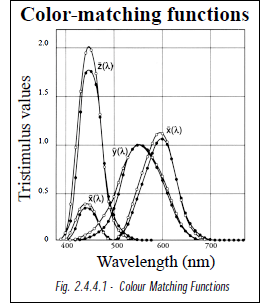Language of Light
2.Concepts
2.4 COLORIMETRY
2.4.4 LIGHT SOURCE COLOUR SPECIFICATION
In the past, various people have devised methods to quantify colour so that communication of colour becomes easier and more accurate. These methods attempt to provide a way of expressing colour numerically, in much the same way we express length and weight.
Light source colour specification and measurement can be categorised into three major colorimetric methods.
They are:
- Tristimulus colorimetry
- Colour temperature
- Spectroradiometry
2.4.4.1 TRISTIMULUS COLORIMETRY
Tristimulus colorimetry is based on the three component theory of colour vision, which states that the eye possesses receptors for three primary colours (red, green, blue) and that all colours are seen as mixtures of these three primary colours. The most important system is the 1931 Commission Internationale I’Eclairage (CIE) system, which defined the Standard Observer to have colour-matching functions x(λ), y(λ), and z(λ) as shown in Fig. 2.4.4.1. The XYZ tristimulus values are calculated using these three standard observer colour matching functions. XYZ tristimulus values and the associated Yxy colour space form the foundation of the present CIE colour space.


